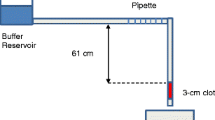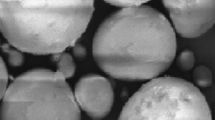Abstract
To deliver drug locally and relieve the syndrome of pain after uterine artery embolization, N-[tris (hydroxymethyl) methyl] acrylamide-gelatin microspheres were prepared based on inverse suspension polymerization and then separated into a number of subgroups (150–350, 350–560, 560–710, 710–1,000, and 1,000–1,430 μm) by wet-sieving. The microspheres were dried by lyophilization or by washing with anhydrous ethanol. And ketoprofen was loaded by soaking dried blank microspheres into concentrated ketoprofen ethanol solution. The ketoprofen loading level in different subgroups of microspheres was measured and found higher when the microspheres were dried by lyophilization. Equilibrium water content and mean diameters of microspheres decreased after drug loading, especially in subgroups with larger size. The microspheres went through the catheter without any difficulty. Compression and relaxation tests were performed on microspheres before lyophilization, embosphere™, microspheres after lyophilization and ketoprofen loading microspheres. The Young’s moduli were 54.74, 64.19, 98.15, and 120.44 kPa, respectively. The release of ketoprofen from microspheres in different subgroups was studied by using the USPII method and T-cell apparatus, respectively. The results indicate that the release rate of ketoprofen depends upon the diameter of microspheres, the type of dissolution apparatus and the flow rate of media in the case that T-cell apparatus was applied. The CH50 test shows that the activation of complement by ketoprofen-loaded microspheres was lower than by blank ones.






Similar content being viewed by others
References
Fleetwood IG, Steinberg GK. Arteriovenous malformations. Lancet. 2002;359:863–73.
Lau WY, Yu SCH, Lai ECH. Leung TWT. Transarterial chemoembolization for hepatocellular carcinoma. J Am Coll Surgeons. 2006;202:155–68.
Bendszus M, Martin-Schrader I, Warmuth-Metz M, Hofmann E, Solymosi L. MR imaging- and MR spectroscopy-revealed changes in meningiomas for which embolization was performed without subsequent surgery. Am J Neuroradiol. 2000;21:666–9.
De Gregorio MA, Medrano J, Mainar A, Alfonso ER, Rengel M. Endovascular treatment of massive hemoptysis by bronchial artery embolization: short-term and long-term follow-up over a 15-year period. Arch Bronconeumol. 2006;42(2):49–56.
Pelage JP, Dref OL, Beregi JP, Nonent M, Robert Y, Cosson M, Jacob D, Truc JB, Laurent A, Rymer R. Limited uterine artery embolization with trisacryl gelatin microspheres for uterine fibroids. J Vasc Interv Radiol. 2003;14:15–20.
Buttram VC Jr, Reiter RC. Uterine leiomyomata: etiology, symptomatology, and management. Fertil Steril. 1981;36:433–5.
Pron G, Cohen M, Soucie J, Garvin G, Vanderburgh L, Bell S. The ontario uterine fibroid embolization trial. Part 1. baseline patient characteristics, fibroid burden, and impact on life. Fertil Steril. 2003;79(1):112–9.
Klein A, Schwartz ML. Uterine artery embolization for the treatment of uterine fibroids: an outpatient procedure. Am J Obstet Gynecol. 2001;184(7):1556–63.
Keyoung JA, Levy EB, Roth AR, Gomez-Jorge J, Chang TC, Spies JB. Intraarterial lidocaine for pain control after uterine artery embolization for leiomyomata. J Vasc Interv Radiol. 2001;12(9):1065–9.
Banu NS, Gaze DC, Bruce H, Collinson PO, Belli AM, Manyonda IT. Markers of muscle ischemia, necrosis, and inflammation following uterine artery embolization in the treatment of symptomatic uterine fibroids. Am J Obstet Gynecol. 2007;196:213.e1–5.
Borovac T, Pelage JP, Kasselouri A, Prognon P, Guiffant G, Laurent A. Release of ibuprofen from beads for embolization: in vitro and in vivo studies. J Control Release. 2006;115:266–74.
Siskin GP, Bonn J, Worthington-Kirsch RL, Smith SJ, Shlansky-Goldberg R, Machan LS, Andrews RT, Goodwin SC, Hovsepian DM. Uterine fibroid embolization: pain management. Tech Vasc Interv Radiol. 2005;5:35–46.
Roth AR, Spies JB, Walsh SM, Wood BJ, Gomez-Jorge J, Levy EB. Pain after uterine artery embolization for leiomyomata: can its severity be predicted and does severity predict outcome? J Vasc Interv Radiol. 2000;11:1047–52.
Bruno J, Sterbis K, Flick P, McCullough M, Cramp M, Murphy-Skrynarz K, Spies JB. Recovery after uterine artery embolization for leiomyomas: a detailed analysis of its duration and severity. J Vasc Interv Radiol. 2004;15:801–7.
Zhan S, Li Y, Wang G, Han H, Yang Z. Effectiveness of intra-arterial anesthesia for uterine fibroid embolization using dilute lidocaine. Eur Radiol. 2005;15:1752–6.
Pisco JM, Bilhim T, Duarte M, Ferreira A, Santos D, Pires FM, Oliveira AG. Pelvic pain after uterine artery embolization: A prospective randomized study of polyvinyl alcohol particles mixed with ketoprofen versus bland polyvinyl alcohol particles. J Vasc Interv Radiol. 2008;19:1537–42.
Emery P, Kong SX, Ehrich EW, Watson DJ, Towheed TE. Dose-effect relationships of nonsteroidal anti-inflammatory drugs: a literature review. Clin Ther. 2002;24(8):1225–91.
Ma N, Xu L, Wang Q, Zhang X, Zhang W, Li Y, Jin L, Li S. Development and evaluation of new sustained-release floating microspheres. Int J Pharm. 2008;358:82–90.
Wang X, Chi N, Tang X. Preparation of estradiol chitosan nanoparticles for improving nasal absorption and brain targeting. Eur J Pharm Biopharm. 2008;70:735–40.
Wei HJ, Yang HH, Chen CH, Lin WW, Chen SC, Lai PH, Chang Y, Sung HW. Gelatin microspheres encapsulated with a nonpeptide angiogenic agent, ginsenoside Rg1, for intramyocardial injection in a rat model with infarcted myocardium. J Control Release. 2007;120:27–34.
Ryu RK, Omary RA, Sichlau MJ, Siddiqi A, Chrisman HB, Nemcek AA Jr, Vogelzang RL. Comparison of pain after uterine artery embolization using trisacryl gelatin microspheres versus polyvinyl alcohol particles. Cardiovasc Intervent Radiol. 2003;26:375–8.
Wu H, Zhang Z, Wu D, Zhao H, Yu K, Hou Z. Preparation and drug release characteristics of pingyangmycin-loaded dextran cross-linked gelatin microspheres for embolization therapy. J Biomed Mater Res B Appl Biomater. 2006;78:56–62.
Liapi E, Lee KH, Georgiades CC, Hong K, Geschwind JFH. Drug-eluting particles for interventional pharmacology. Tech Vasc Interv Radiol. 2007;10:261–9.
Taylor RR, Tang YM, Gonzalez V, Stratford PW, Lewis AL. Irinotecan drug eluting beads for use in chemoembolization: in vitro and in vivo evaluation of drug release properties. Eur J Pharm Sci. 2007;30:7–14.
Lewis AL, Holden RR. DC Bead embolic drug-eluting bead: clinical application in the locoregional treatment of tumorss. Expert Opin Drug Deliv. 2011;8(2):153–69.
Lewis AL. DC Bead?: a major development in the toolbox for the interventional oncologist. Expert Rev Med Devices. 2009;6(4):389–400.
Forster REJ, Small SA, Tang Y, Heaysman CL, Lloyd AW, MacFarlane W, Phillips GJ, Antonijevic MD, Lewis AL. Comparison of DC Bead-irinotecan and DC Bead-topotecan drug eluting beads for use in locoregional drug delivery to treat pancreatic cancer. J Mate Sci Mater Med. 2010;21(9):2683–90.
Laurent A, Beaujeux R, Wassef M, Ru fenacht D, Boschetti E, Merland JJ. Trisacryl gelatin microspheres for therapeutic embolization, I: development and in vitro evaluation. Am J Neuroradiol. 1996;17:533–40.
Perlovich GL, Kurkov SV, Kinchin AN, Bauer-Brandl A. Thermodynamics of solutions IV: solvation of ketoprofen in comparison with other NSAIDs. J Pharm Sci. 2003;92:2502–11.
Mauricio G, Alicia Y, Fleming M. Solution thermodynamics of ketoprofen in ethanol + water cosolvent mixtures. Chem Eng Data. 2010;55:113–8.
Wassef M, Pelage JP, Venzenberger E, Namur J, Schwartz-Cornil I, Taylor RR, Lewis AL, Laurent A. Anti-inflammatory effect of ibuprofen-loaded embolization beads in sheep uterus. J Biomed Mater Res B Appl Biomater. 2008;86B:63–73.
Lewis AL, Gonzalez MV, Lloyd AW, Hall B, Tang Y, Willis SL, Leppard SW, Phil D, Wolfenden LC, Palmer RR, Stratford PW. DC bead: in vitro characterization of a drug-delivery device for transarterial chemoembolization. J Vasc Interv Radiol. 2006;17:335–42.
Gibas I, Janik H. Review: synthetic polymer hydrogels for biomedical applications. Chem Chem Tech. 2010;4(4):297–304.
Hidaka K, Moine L, Collin G, Labarre D, Grossiord JL, Huang N, Osuga K, Wada S, Laurent A. Elasticity and viscoelasticity of embolization microspheres. J Mech Behav Biomed Mater. doi:10.1016/j.jmbbm.2011.08.001.
Hidaka K, Nakamura M, Osuga K, Miyazaki H, Wada S. Elastic characteristics of microspherical embolic agents used for vascular interventional radiology. J Mech Behav Biomed Mater. 2010;3:497–503.
Laurent A. Microspheres and nonspherical particles for embolization. Tech Vasc Interv Radiol. 2007;10(4):248–56.
Amyot F, Boudy V, Jurski K, Counord JL, Guiffant G, Dufaux J, Chaumeil JC. A new experimental method for the evaluation of the release profiles of drug loaded microbeads designed for embolisation. ITBM-RBM. 2002;23:285–9.
Amyot F, Jurski K, Dufaux J, Guiffant G. An experimental and theoretical study of mass transfer from loaded embolization microbeads: possible optimisation. Int Commun Heat Mass Transf. 2002;29:623–32.
Gonzalez MV, Tang Y, Phillips GJ, Lloyd AW, Hall B, Stratford PW, Lewis AL. Doxorubicin eluting beads—2: methods for evaluating drug elution and in vitro: in vivo correlation. J Mater Sci Mater Med. 2008;19:767–75.
Lewis AL, Adams C, Busby W, Jones SA, Wolfenden LC, Leppard SW, Palmer RR, Small S. Comparative in vitro evaluation of microspherical embolisation agents. J Mater Sci Mater Med. 2006;17:1193–204.
Vonarbourg A, Passirani C, Saulnier P, Benoit JP. Parameters influencing the stealthiness of colloidal drug delivery systems. Biomaterials. 2006;27:4356–73.
Madani F, Bessodes M, Lakrouf A, Vauthier C, Scherman D, Chaumeil JC. PEGylation of microspheres for therapeutic embolization: preparation, characterization and biological performance evaluation. Biomaterials. 2007;28:1198–208.
Labarre D, Laurent A, Lautier A, Bouhni S, Kerbellec L, Lewest JM, Tersinet N. Complement activation by substituted polyacrylamide hydrogels for embolisation and implantation. Biomaterials. 2002;23:2319–27.
Verret V, Bevilacqua C, Schwartz-Cornil I, Pelage JP, Wassef M, Namur J, Bedouet J, Lewis AL, Laurent A. IL6 and TNF expression in vessels and surrounding tissues after embolization with ibuprofen-loaded beads confirms diffusion of ibuprofen. Eur J Pharm Sci. 2011;42(5):489–95.
Acknowledgments
This study was supported by the State Key Projects (No.2009ZX09310-001). The authors wish to thank Ensoul Technology Ltd. for measuring elasticity of microspheres.
Author information
Authors and Affiliations
Corresponding author
Rights and permissions
About this article
Cite this article
Zhou, C., Cui, D., Zhang, Y. et al. Preparation and characterization of ketoprofen-loaded microspheres for embolization. J Mater Sci: Mater Med 23, 409–418 (2012). https://doi.org/10.1007/s10856-011-4492-3
Received:
Accepted:
Published:
Issue Date:
DOI: https://doi.org/10.1007/s10856-011-4492-3




